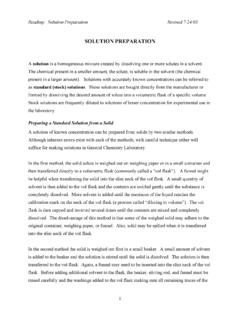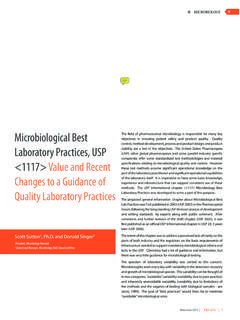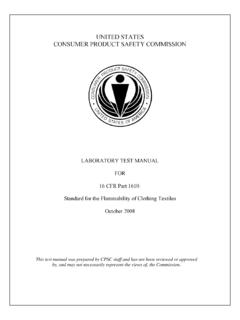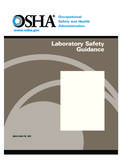Transcription of GOOD LABORATORY PRACTICES - Centers for Medicare ...
1 good LABORATORY PRACTICES . 1) Keep the manufacturer's product insert for the LABORATORY test in use and be sure it is available to the testing personnel. Use the manufacturer's product insert for the kit currently in use; do not use old product inserts. 2) Follow the manufacturer's instructions for specimen collection and handling. a) Are specimens stored at the proper temperature? b) Are the appropriate collection containers used? 3) Be sure to properly identify the patient. a) Does the name on the test requisition (or prescription) match the patient's name?
2 B) Does the name on the patient's chart match the name on the patient's identification? c) If more than one patient is present with the same first and last name, how do you determine which one is the test patient? (Look for possible gender differences, social security number, patient identification number, birthdates, different middle name, and relevance of the test to the patient's history). 4) Be sure to label the patient's specimen for testing with an identifier unique to each patient. 5) Inform the patient of any test preparation such as fasting, clean catch urines, etc.
3 6) Read the product insert prior to performing a test. a) Become familiar with the test procedure. b) Study each step and perform them in the proper order. c) Know the time required for performing the test and achieving the optimal result. d) Be sure to have all of the required reagents and equipment ready before actually performing the test. e) Be able to recognize when the test is finished will there be a blue plus or minus sign against a white background? f) Follow the manufacturer's instructions and when a new kit is opened, perform the quality control to be sure that the kit works prior to testing patient samples.
4 7) Follow the storage requirements for the test kit. If the kit can be stored at room temperature but this changes the expiration date, write the new expiration date on the kit. 8) Do not mix components of different kits! 9) Record the patients' test results in the proper place, such as the patient's chart or the LABORATORY test log, but not on unidentified post-it notes or pieces of scrap paper that can be misplaced. a) Record the results according to the instructions in the manufacturer's product insert. b) If it's a qualitative test, spell out positive/negative or pos/neg because symbolic representations can be altered (the can be altered to a +).
5 C) Include the name of the test, the date the test was performed, and the initials of the testing personnel in the test record. Include the calendar year in the date. d) If the same test is performed on a patient multiple times in one day, include the time of each test. 10) Perform any instrument maintenance as directed by the manufacturer. GLOSSARY. 1) CLIA means the Clinical LABORATORY Improvement Amendments of 1988. 2) Certificate of waiver (COW) allows a facility to do only waived tests. 3) PPMP Certificate allows qualified providers to do waived testing and certain microscopic examinations during the patients' visit.
6 4) Certificate of registration or registration certificate means a certificate issued to a LABORATORY that enables the entity to conduct moderate or high complexity LABORATORY testing or both until the entity is determined to be in compliance through a survey by the Centers for Medicare and Medicaid Services (CMS) or its agent; or in accordance with Sec. to an entity that is accredited by an approved accreditation organization. 5) HHS means the Department of Health and Human Services, or its designee. 6) Kit means all components of a test that are packaged together.
7 7) LABORATORY means a facility for the examination of materials derived from the human body for the purpose of providing information for the diagnosis, prevention, or treatment of any disease or impairment of, or the assessment of the health of, human beings. These examinations also include procedures to determine, measure, or otherwise describe the presence or absence of various substances or organisms in the body. Facilities only collecting or preparing specimens (or both) or only serving as a mailing service and not performing testing are not considered laboratories.
8 8) MedWatch: FDA service for health care facilities to voluntarily report a serious adverse event or product problem that the user suspects is associated with a drug or medical device used, prescribed, or dispensed. Online: Phone: 1-800-FDA-1088. 9) A pipet/pipette is a narrow, usually calibrated glass or plastic tube into which small amounts of liquid are suctioned for transfer or measurement. 10) Plasma is the usually clear, yellowish fluid portion of blood, lymph, or intramuscular fluid in which cells are suspended.
9 It is the fluid produced when a blood specimen is collected in a vacuum tube with anticoagulant. 11) Serum is the usually clear yellowish fluid obtained upon separating whole blood into its solid and liquid components after it has been allowed to clot. Also called blood serum. 12) A reagent is a substance or material or ingredient used in a lab test to detect, measure, examine, or produce other substances. 13) Controls are materials with known values of the substance measured that help the LABORATORY achieve accurate and reliable testing by checking if the test system is working.
10 Controls, also known as quality control material, are external or internal. External controls are usually a liquid and are processed or tested in the same manner as a patient specimen. Internal or procedural controls are indicators that the test procedure was performed in the proper order. 2. 14) Quality Control (QC) procedures help to ensure the excellence of the patient testing. If the QC. results are not within the prescribed range or the expected pattern, then the LABORATORY cannot be sure that the patients test results are accurate and reliable.
















